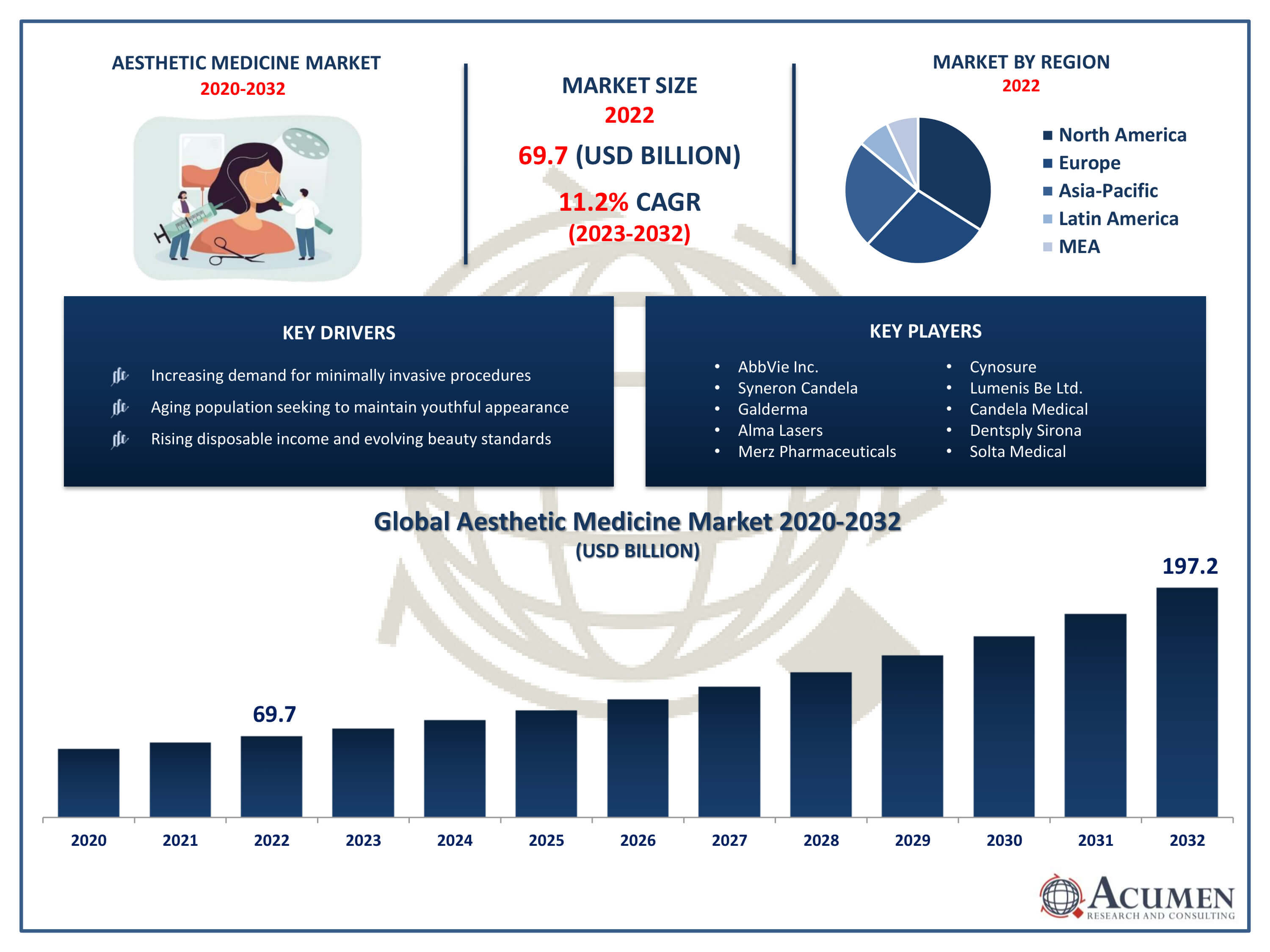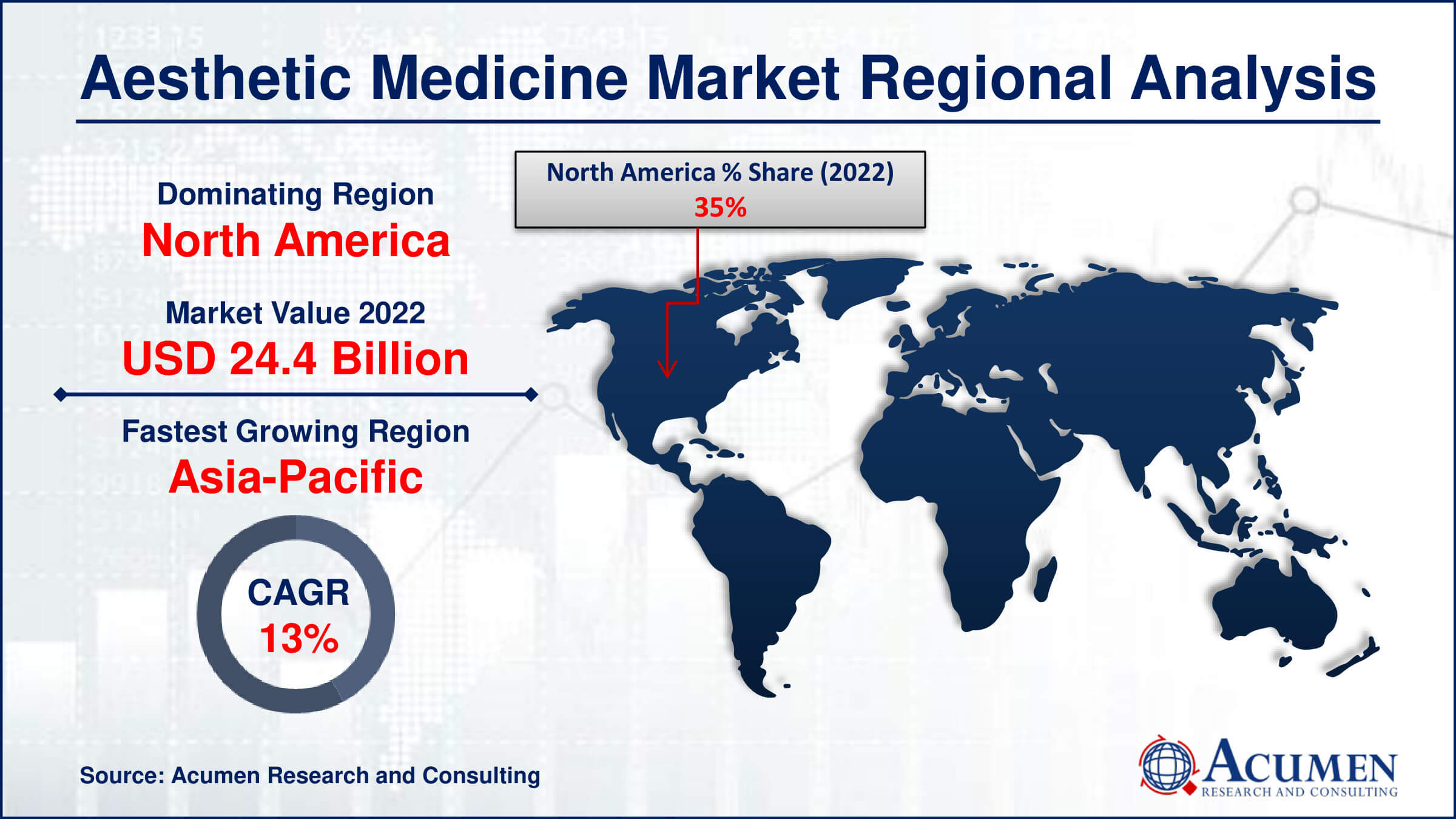March 2025
Aesthetic Medicine Market Size accounted for USD 69.7 Billion in 2022 and is projected to achieve a market size of USD 197.2 Billion by 2032 growing at a CAGR of 11.2% from 2023 to 2032.
The Aesthetic Medicine Market Size accounted for USD 69.7 Billion in 2022 and is projected to achieve a market size of USD 197.2 Billion by 2032 growing at a CAGR of 11.2% from 2023 to 2032.
Aesthetic Medicine Market Highlights
 Aesthetic medicine, or cosmetic medicine, encompasses various procedures and treatments aimed at enhancing a person's appearance, ranging from injectables like Botox to surgical interventions such as liposuction. The field prioritizes achieving aesthetic appeal while maintaining natural-looking results, emphasizing symmetry and proportion. In recent years, the market for aesthetic medicine has seen remarkable growth, driven by several factors. One significant factor is the rising demand for minimally invasive procedures, which offer quick results with minimal downtime. According to ASAPS, over 23 million cosmetic minimally invasive procedures were performed in 2022 alone. Over the past two decades, there has been a notable surge in cosmetic procedures, with a 131% increase reported from 2000 to 2020. Notably, there has been a shift towards minimally invasive procedures, with a remarkable 174% increase during the same period. Technological advancements and improved techniques have contributed to safer and more effective treatments, attracting a broader range of patients. Additionally, societal trends emphasizing youthfulness and self-care have bolstered the acceptance and popularity of aesthetic procedures. As a result, the aesthetic medicine market is poised for continued growth as new treatments emerge, catering to the increasing demand for aesthetic enhancements and boosting individual confidence.
Aesthetic medicine, or cosmetic medicine, encompasses various procedures and treatments aimed at enhancing a person's appearance, ranging from injectables like Botox to surgical interventions such as liposuction. The field prioritizes achieving aesthetic appeal while maintaining natural-looking results, emphasizing symmetry and proportion. In recent years, the market for aesthetic medicine has seen remarkable growth, driven by several factors. One significant factor is the rising demand for minimally invasive procedures, which offer quick results with minimal downtime. According to ASAPS, over 23 million cosmetic minimally invasive procedures were performed in 2022 alone. Over the past two decades, there has been a notable surge in cosmetic procedures, with a 131% increase reported from 2000 to 2020. Notably, there has been a shift towards minimally invasive procedures, with a remarkable 174% increase during the same period. Technological advancements and improved techniques have contributed to safer and more effective treatments, attracting a broader range of patients. Additionally, societal trends emphasizing youthfulness and self-care have bolstered the acceptance and popularity of aesthetic procedures. As a result, the aesthetic medicine market is poised for continued growth as new treatments emerge, catering to the increasing demand for aesthetic enhancements and boosting individual confidence.
Global Aesthetic Medicine Market Trends
Market Drivers
Market Restraints
Market Opportunities
Aesthetic Medicine Market Report Coverage
| Market | Aesthetic Medicine Market |
| Aesthetic Medicine Market Size 2022 | USD 69.7 Billion |
| Aesthetic Medicine Market Forecast 2032 | USD 197.2 Billion |
| Aesthetic Medicine Market CAGR During 2023 - 2032 | 11.2% |
| Aesthetic Medicine Market Analysis Period | 2020 - 2032 |
| Aesthetic Medicine Market Base Year |
2022 |
| Aesthetic Medicine Market Forecast Data | 2023 - 2032 |
| Segments Covered | By Procedure Type, By Product, By Application, By End-User, And By Geography |
| Regional Scope | North America, Europe, Asia Pacific, Latin America, and Middle East & Africa |
| Key Companies Profiled | AbbVie Inc., Syneron Candela, Galderma, Alma Lasers, Merz Pharmaceuticals, Cynosure, Lumenis Be Ltd., Candela Medical, Johnson & Johnson Private Limited, Dentsply Sirona, Solta Medical, and Hologic, Inc. |
| Report Coverage |
Market Trends, Drivers, Restraints, Competitive Analysis, Player Profiling, Covid-19 Analysis, Regulation Analysis |
Aesthetic medicine is a specialized field within medicine that focuses on enhancing an individual's appearance through non-invasive to minimally invasive procedures. It encompasses a wide range of treatments and techniques designed to improve cosmetic concerns and enhance overall beauty. Aesthetic medicine procedures are typically performed by trained medical professionals, such as dermatologists, plastic surgeons, or specialized practitioners, in clinical settings. The applications of aesthetic medicine are diverse and cater to various cosmetic concerns and desires of individuals. Common applications include wrinkle reduction through treatments like botox injections, restoring volume and contour with dermal fillers, skin rejuvenation through chemical peels or laser therapy, and hair removal via laser or intense pulsed light (IPL) treatments. Aesthetic medicine also addresses issues such as acne scars, uneven skin tone, and pigmentation irregularities. Moreover, it extends to body contouring procedures like liposuction, non-surgical fat reduction, and cellulite reduction treatments. As per the American Society of Plastic Surgeons report statistics, 1,498,361 cosmetic surgical procedures had been performed in 2022.
The aesthetic medicine market has witnessed robust growth in recent years, driven by a convergence of demographic, technological, and cultural factors. With an increasing emphasis on appearance and beauty standards globally, there has been a surge in demand for cosmetic procedures aimed at enhancing one's physical appearance. This demand is further fueled by the aging population seeking to maintain a youthful look and the growing acceptance of aesthetic treatments as a means of self-care and confidence enhancement. Moreover, advancements in medical technology and techniques have played a pivotal role in the expansion of the aesthetic medicine market. Innovations such as minimally invasive procedures, personalized treatment plans, and safer, more effective products have significantly widened the scope of available cosmetic options. Additionally, the influence of social media and digital platforms has heightened awareness and accessibility to aesthetic procedures, contributing to market growth.
Aesthetic Medicine Market Segmentation
The global aesthetic medicine market segmentation is based on procedure type, product, application, end-user, and geography.
Aesthetic Medicine Market By Procedure Type
According to the aesthetic medicine industry analysis, the non-invasive procedure segment accounted for the largest market share in 2022. Non-invasive procedures encompass a wide range of treatments, including laser therapy, injectables like botox and dermal fillers, chemical peels, and microdermabrasion, among others. As per the ASPS data, 8,736,591 people received Neuromodulator injection which includes Botox, Dysport, Xeomin, and Jeuveau. These procedures offer patients the opportunity to enhance their appearance without the need for surgery, making them increasingly popular among individuals seeking cosmetic improvements without significant risks or recovery periods. One of the key drivers of growth in the non-invasive procedure segment is the continuous innovation and advancement in technology, which has led to the development of more effective and versatile treatment options. For instance, advancements in laser technology have resulted in safer and more precise procedures for skin rejuvenation, hair removal, and tattoo removal.
Aesthetic Medicine Market By Product
In terms of products, the energy-based devices segment is expected to witness significant growth in the coming years. Energy-based devices utilize various forms of energy such as laser, radiofrequency, ultrasound, and light-based technologies to target specific skin concerns and deliver precise and effective treatments. These devices are utilized for a wide range of applications including skin tightening, body contouring, hair removal, scar reduction, and tattoo removal, among others. One of the key factors contributing to the growth of the energy-based devices segment is the continuous innovation and development of these technologies, leading to improved efficacy, safety, and patient satisfaction. Advancements in laser and light-based technologies have enabled practitioners to deliver highly customizable treatments with minimal downtime and fewer side effects. Similarly, the integration of radiofrequency and ultrasound technologies has expanded the scope of energy-based treatments, allowing for deeper tissue penetration and more comprehensive results.
Aesthetic Medicine Market By Application
According to the aesthetic medicine market forecast, the non-surgical segment is expected to witness significant growth in the coming years. This growth is driven by a multitude of factors including technological advancements, changing consumer preferences, and increasing accessibility to aesthetic procedures. This segment encompasses a wide array of non-invasive and minimally invasive treatments such as injectables, laser therapy, chemical peels, and microdermabrasion, among others. These procedures offer patients the opportunity to enhance their appearance with reduced risks, downtime, and discomfort compared to traditional surgical interventions. One of the primary drivers of growth in the non-surgical segment is the continuous innovation in aesthetic implants and techniques. Advancements in laser technology, for instance, have led to the development of more precise and versatile devices capable of targeting a variety of skin concerns including wrinkles, pigmentation, and acne scars.
Aesthetic Medicine Market By End-User
Based on the end-user, the medical spas and beauty centres segment is expected to continue its growth trajectory in the coming years. As per our analysis, global medical spas market is exected to reach more than USD 16 billion by 2024, with a 12.6% CAGR from 2023 to 2032. Medical spas and beauty centers offer a range of aesthetic services, including non-invasive procedures, skincare treatments, and wellness services, all under the supervision of qualified medical professionals. These establishments provide clients with a one-stop destination for comprehensive aesthetic and rejuvenation services in a relaxing and luxurious environment. One of the key drivers of growth in this segment is the increasing demand for personalized and tailored aesthetic treatments. Medical spas and beauty centers offer clients customized treatment plans that cater to their specific needs and goals, enhancing the overall experience and satisfaction. Additionally, the integration of advanced technologies and innovative treatments within these establishments has further fueled their popularity, attracting clients seeking the latest and most effective aesthetic solutions.
Aesthetic Medicine Market Regional Outlook
North America
Europe
Asia-Pacific
Latin America
The Middle East & Africa

Aesthetic Medicine Market Regional Analysis
North America asserts dominance in the aesthetic medicine market through a combination of factors including advanced healthcare infrastructure, high disposable income levels, and a culture that places significant value on appearance and youthfulness. The region benefits from a robust network of medical professionals, cutting-edge technology, and stringent regulatory standards that ensure the safety and efficacy of aesthetic procedures. Additionally, North America boasts a thriving cosmetic industry with a wide array of products and services tailored to meet the diverse needs and preferences of consumers. Moreover, the region's affluent population contributes significantly to the growth of the aesthetic medicine market, as individuals with higher disposable incomes are more likely to invest in cosmetic procedures to maintain their youthful appearance and enhance their overall aesthetic appeal. Furthermore, the pervasive influence of media and celebrity culture in North America plays a crucial role in shaping beauty standards and driving demand for aesthetic treatments. The constant exposure to images of idealized beauty fuels the desire for cosmetic enhancements among individuals, further propelling the growth of the aesthetic medicine market in the region.
The Asia-Pacific aesthetic medicine market is expanding rapidly, owing to a number of causes. Rising disposable incomes, more beauty consciousness, and an aging population are driving up demand for cosmetic services throughout the area. Countries such as China, Japan, South Korea, and India are developing as key market contributors, with a growing middle class demanding sophisticated cosmetic procedures. Furthermore, technical improvements in aesthetic medicine, along with the increased availability of less invasive procedures, are attracting a wider range of patients. Furthermore, the region's medical tourism industry is growing, with patients from neighboring nations and beyond looking for high-quality yet affordable cosmetic operations in Asia-Pacific. Regulatory improvements aimed at enhancing patient safety and quality standards are also influencing the market environment, providing chances for both local and foreign firms to profit on the region's expanding demand for aesthetic treatments.
Aesthetic Medicine Market Player
Some of the top aesthetic medicine market companies offered in the professional report include AbbVie Inc., Syneron Candela, Galderma, Alma Lasers, Merz Pharmaceuticals, Cynosure, Lumenis Be Ltd., Candela Medical, Johnson & Johnson Private Limited, Dentsply Sirona, Solta Medical, and Hologic, Inc.
Looking for discounts, bulk pricing, or custom solutions? Contact us today at sales@acumenresearchandconsulting.com
March 2025
April 2021
June 2022
October 2021